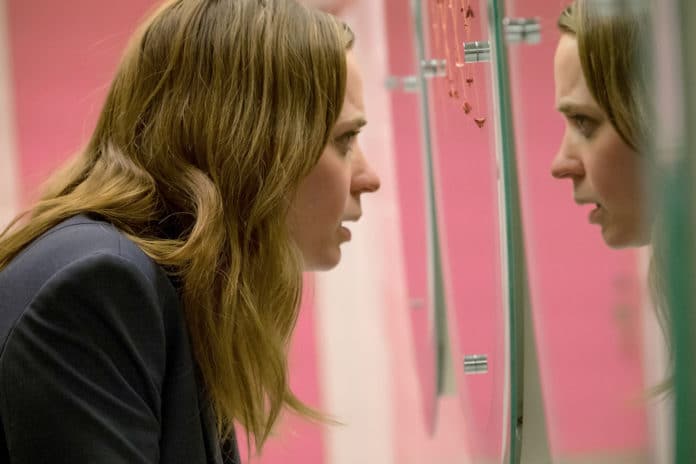“The Girl on the Train” is a dour piece of suburban miserablism, a peek under the attractive surface of lazily entitled upper-class ennui that reveals dysfunction and seeping pathology underneath.
As wan in spirit as it is devoid of color and life, it goes from glum to ghastly, with little in the way of genuine intrigue between. If “The Girl on the Train” were a musical instrument, it would be a sad trombone.
Emily Blunt plays Rachel Watson, a barely functioning alcoholic living in Westchester County who has lost her job because of her drinking. Every day, she performs the pantomime of commuting into New York on the Metro North train, nursing a water bottle filled with vodka and using her view out the window to spy on ex-husband Tom (Justin Theroux), his new wife Anna (Rebecca Ferguson) and their adorable baby, while also checking in on a neighboring couple she observes just as longingly.
Rachel is particularly taken with the female half of that young, attractive, obviously sexually fulfilled twosome. Her name turns out to be Megan (Haley Bennett), and her real life bears little resemblance to the fantasy Rachel has concocted in her booze-addled head. As Rachel’s obsession deepens, the boundaries begin to blur between appearance and reality, with Rachel’s regrets over her failed marriage, her blackout binges and her barely controlled rage culminating in a mysterious incident that she spends the rest of the movie trying to sort out.
Based on Paula Hawkins’ 2015 novel of the same name, “The Girl on the Train” has retained the book’s somewhat scrambled timeline and multiple voices. (Megan and Anna have their own say, as well.) The story has been transposed from London, but Rachel retains the British accent. Still, she seems to have lost a bit of her edge in the move across the pond. With conspicuously chapped lips, raccoon eyes and a perpetually flushed nose, Blunt plays her in a weepy, self-pitying daze.
Although the supporting cast is strong, no one has much to do in a procedural that classic film fans might well suss out within the first 20 minutes. Edgar Ramirez is particularly wasted as an ethically challenged psychiatrist who at one point simply disappears, never to return to the narrative in which he has figured so prominently.
Directed in chilly tones of blue and gray by Tate Taylor, “The Girl on the Train” might inevitably be compared to “Gone Girl” as a female-centered thriller about maternal ambivalence with “girl” in the title, but the juxtaposition only points up how much this movie lacks in sly wit, adroit misdirection and feminist provocation. If the audience comes away with a message, it’s that women need to talk to one another, lest we come under the potentially fatal spell of manipulative, controlling men. The most poignant example comes in one of the movie’s most effective scenes, featuring a peppery, sharply alert turn by Lisa Kudrow.
That brief spike of energy is momentary, however, and soon we’re returned to dreary monotony. “The Girl on the Train” plods toward what turns out to be a startlingly gruesome resolution. Even viewers who are mildly diverted by the whodunit angle are unlikely to find themselves emotionally engaged in the outcome.
It’s a movie that chugs along, smoothly and uneventfully, until it pulls into a station that could have been seen from a mile away, had you not already been lulled just to the edge of sleep.
—
One and one-half stars. Rated R. Contains violence, obscenity, sexuality and nudity. 112 minutes.
Ratings Guide: Four stars masterpiece, three stars very good, two stars OK, one star poor, no stars waste of time.






